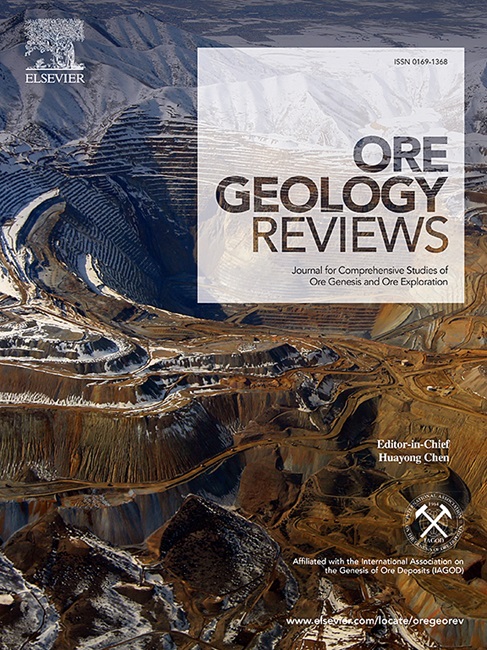蒙古东北部乌兰银铅锌矿床的成因:来自S和Pb同位素以及U-Pb和Rb-Sr地质年代学的制约因素
IF 3.2
2区 地球科学
Q1 GEOLOGY
引用次数: 0
摘要
乌兰银铅锌矿床(以下简称乌兰矿床)被认定为蒙古最大的银铅锌多金属矿床,探明储量包括 2240 吨银(Ag;平均品位:49 克/吨)、44 万吨铅(Pb;平均品位:1.13%)和 81 万吨锌(Zn;平均品位:2.07%)。然而,该矿床的成因仍不清楚。该矿床中的银铅锌矿体呈圆柱形,位于中-晚侏罗世流纹岩中,由一个隐蔽的角砾岩管控制。矿石矿物包括方铅矿、闪锌矿和黄铁矿,其次是黄铜矿、赤铁矿、闪锌矿和菱铁矿。周围岩石的主要蚀变包括硅化、绿泥石化、高岭土化、芒硝化、碳酸盐化和矽卡岩化。对矿石中的硫化物矿物和相关脉石矿物进行的铷-锶定年测定得出的等时线年龄在 146 ± 3 Ma 之间(n = 6,MSWD=1.3),表明矿化过程发生在晚侏罗世。矿石中硫化物矿物的δ34S值在1.6‰到4.3‰之间,表明硫主要来源于岩浆或深部来源。矿床中共生闪锌矿-方铅矿矿物的同位素组成显示,成矿温度估计在 331 ℃ 至 449 ℃ 之间,表明成矿条件为中高温。硫化物矿物的 208Pb/204Pb 比值范围为 38.138 至 38.301,207Pb/204Pb 比值范围为 15.543 至 15.594,206Pb/204Pb 比值范围为 18.318 至 18.354,表明以 Pb 为代表的成矿金属也主要来源于地幔。对成矿地层和控矿角砾岩管中的流纹岩进行的锆石U-Pb测年显示,其年龄分别为160.6 ± 1.7 Ma(n = 24,MSWD=0.68)和161.6 ± 1.6 Ma(n = 30,MSWD=0.89),表明在晚侏罗世早期有火山喷发。这些矿床流纹岩表现出 A 型流纹岩的特征,表明它们是在大陆内部延伸环境中形成的。这些流纹岩与主要成矿阶段形成的萤石具有相似的稀土元素(REE)分布模式,表明成矿与岩浆过程之间存在遗传联系。本研究提出,乌兰矿床是蒙古-奥霍次克洋关闭后在伸展环境中形成的热液矿床,成矿金属和热液与火山岩或岩浆-热液过程有关。本文章由计算机程序翻译,如有差异,请以英文原文为准。

Genesis of the Ulaan silver-lead–zinc deposit in Northeast Mongolia: Constraints from S and Pb isotopes, together with U-Pb and Rb-Sr geochronology
The Ulaan silver-lead–zinc deposit (hereinafter referred to as the Ulaan deposit) is identified as the largest silver-lead–zinc polymetallic deposit in Mongolia, with proved reserves including 2,240 tons of silver (Ag; average grade: 49 g/t), 440,000 tons of lead (Pb; average grade: 1.13 %), and 810,000 tons of zinc (Zn; average grade: 2.07 %). However, the genesis of this deposit remains unclear. The Ag-Pb-Zn ore bodies in the deposit, occurring as cylinders in shape within the Middle-Late Jurassic rhyolites, are governed by a concealed breccia pipe. The ore minerals include galena, sphalerite, and pyrite, followed by chalcopyrite, hematite, stibnite, and siderite. The primary alterations of the surrounding rocks include silicification, chloritization, kaolinization, argillization, carbonatization, and skarnization. The Rb-Sr dating of sulfide minerals and associated vein minerals in the ores yielded isochron ages varying in a range of 146 ± 3 Ma (n = 6, MSWD=1.3), suggesting mineralization during the Late Jurassic. The δ34S values of sulfide minerals in the ores range from 1.6 ‰ to 4.3 ‰, suggesting that the sulfur originated primarily from magmas or deep sources. The isotopic compositions of coexisting sphalerite-galena minerals in the deposit revealed mineralization temperature estimates ranging between 331 °C and 449 °C, indicating a medium- to high-temperature ore-forming conditions. The sulfide minerals exhibit 208Pb/204Pb ratios ranging from 38.138 to 38.301, 207Pb/204Pb ratios from 15.543 to 15.594, and 206Pb/204Pb ratios from 18.318 to 18.354, suggesting that ore-forming metals, represented by Pb, also originated primarily from mantle source. The zircon U-Pb dating of rhyolites in the ore-hosting strata and ore-controlling breccia pipes yielded ages of 160.6 ± 1.7 Ma (n = 24, MSWD=0.68) and 161.6 ± 1.6 Ma (n = 30, MSWD=0.89), respectively, indicating volcanic eruptions during the early Late Jurassic. These ore-hosting rhyolites exhibit characteristics of A-type rhyolites, suggesting that they were formed in an intracontinental extensional environment. These rhyolites share similar rare earth element (REE) distribution patterns with fluorite formed in the main mineralization stage, suggesting a genetic link between the mineralization and magmatic processes. This study proposes that the Ulaan deposit was a hydrothermal deposit formed in an extensional environment following the closure of the Mongol-Okhotsk Ocean, with ore-forming metals and hydrothermal fluids associated with volcanic rocks or magmatic-hydrothermal processes.
求助全文
通过发布文献求助,成功后即可免费获取论文全文。
去求助
来源期刊

Ore Geology Reviews
地学-地质学
CiteScore
6.50
自引率
27.30%
发文量
546
审稿时长
22.9 weeks
期刊介绍:
Ore Geology Reviews aims to familiarize all earth scientists with recent advances in a number of interconnected disciplines related to the study of, and search for, ore deposits. The reviews range from brief to longer contributions, but the journal preferentially publishes manuscripts that fill the niche between the commonly shorter journal articles and the comprehensive book coverages, and thus has a special appeal to many authors and readers.
 求助内容:
求助内容: 应助结果提醒方式:
应助结果提醒方式:


